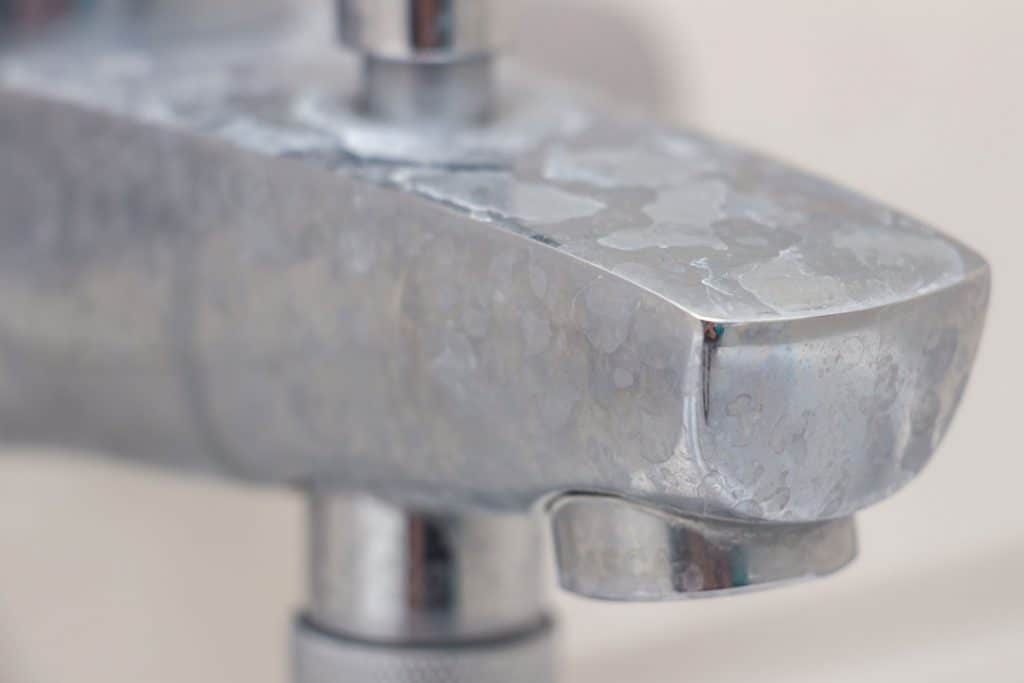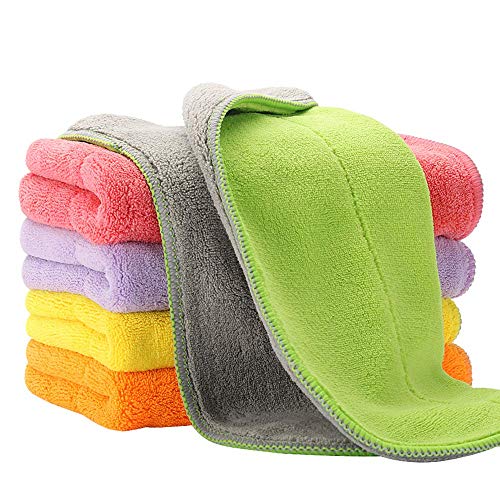Hard water spots are common on bathroom fixtures, no matter what material they are made of. Depending on how long the stain has had to set and the elements present in the water, some stains can be more challenging to remove than others. For this post, we researched how to get those hard water spots off of your bathroom fixtures.
Here are the steps to remove water spots from your metal, glass, and plastic bathroom fixtures:
- Don a pair of rubber gloves
- Apply the cleaner to a cleaning pad
- Clean the fixture
- Rinse the fixture off
- Buff the fixture dry
Hard water stains are formed from magnesium and calcium ions that build up on the surface of bathroom fixtures. Depending on where you live, you may have more unfiltered minerals in your water than in other areas, causing your bathroom fixtures to develop hard water stains more quickly. Continue reading to learn how to get rid of these stains and keep them at bay.
Steps To Get Water Spots Off Bathroom Fixtures

Things you’ll need:
- Plastic gloves
- Metal cleaner
- Bathroom cleaner
- Spray bottle
- Toothbrush
- Toilet brush
- Sponge
- Cleaning cloth
1. Don a pair of rubber gloves
Sometimes the chemicals used to remove hard water stains can be a bit harsh, which makes wearing rubber gloves an absolute must when working with them. Not only can these gloves prevent you from scraping your hand when working with scouring pads, but they can also keep you from developing skin irritations when dealing with harsh chemicals.
See these rubber gloves on Amazon.
2. Apply the cleaner to a cleaning pad
Depending on the material that your bathroom fixture is made of, you’ll want to use a cleaning cloth, scrubbing pad, or soft-bristled brush. Surfaces such as metal, except for brushed nickel, glass, porcelain, and plastic can be cleaned with a soft bristle brush, while more delicate materials such as brass or zinc may require a cloth to prevent scratching them.
See these cleaning pads on Amazon.
3. Clean the fixture
Wipe the bathroom fixture down using your cloth or cleaning pad. If you are using a disposable toothbrush to clean your bathroom fixture, be sure to place an ample amount of the cleaner on to the toothbrush. Also, make sure to get around the areas of the fixture will water is likely to accumulate.
This includes the filter and the bottom base of faucets, and the spray holes of showerheads. If the fixture has not been cleaned in a while, you may need to let the cleaner sit for about two to three minutes to loosen the mineral deposits before scrubbing it away. Apply additional cleaner as needed until all visible water stains are gone.
4. Rinse the fixture off
Next, take a clean cloth, dip it in warm water and wipe down the bathroom fixture. Be sure to remove all traces of the cleaner, as you don’t want it to create a film on the surface of the fixture. You may need to rinse the cloth multiple times if there were a lot of stubborn stains to remove. If possible, get a small disposable cup and pour water over the fixture to rinse off any remaining cleaner.
5. Buff the fixture dry
After you have removed the cleaner, take a clean dry cloth and buff the fixture, making sure to get any hard-to-reach areas or areas where water is likely to accumulate. Once you are done, take a step back and look at the fixture to ensure that you have removed all of the stains. Sometimes it can be hard to tell if all of the stains are completely gone while the fixture is still wet.
See these microfiber cloths on Amazon.
Homemade Methods To Get Rid Of Hard Water Spots
You don’t need commercial cleaners to get rid of hard water stains. In fact, you may already have a few cleaning solutions right in your kitchen pantry. Let’s take a look at a couple of them and how to apply them to get rid of water stains on your bathroom fixtures.
Vinegar & Water Solution
- Vinegar is one of the best hard water stain-fighting solutions that you can use–and it’s also fairly inexpensive to purchase. Here’s how to use vinegar to clean your fixtures.
- Pour 2 cups of vinegar into a spray bottle and combined it with two cups of tap water. Gently agitate the bottle to mix the homemade cleaning solution.
- Next, spray the bathroom fixture with the solution and allow it to sit for about 2 to 3 minutes to break up any hard water stains or grime. You may want to watch a clock or set a timer, as you don’t want the vinegar to sit on the bathroom fixture for very long. Vinegar is a great cleaner, but it’s all so acidic and can eat away at your fixtures if left on too long. Next, wipe down or scrub the vinegar into the fixture to break up the hard water stains.
- Next, take your cloth or cleaning pad and wipe down the picture from top to bottom, removing all of the solution.
- After you have removed the solution, take a damp cloth and wipe down the fixture to remove the solution.
See this distilled vinegar on Amazon.
Baking Soda & Water
Baking soda has long been known for its exceptional cleaning and deodorizing properties. And it doesn’t fall short when it comes to removing hard water stains from bathroom fixtures either. Let’s look at how to use baking soda to get rid of these things.
- Start by pouring 2 tablespoons of baking soda into a bowl.
- Next, pour 6 tablespoons of water into the bowl, mix it with the baking soda, and form a paste.
- Take a cleaning pad are cloth and apply the paste to your bathroom fixtures. Depending on the extent of the stain, you may need to let the paste sit for anywhere from 5 to 10 minutes to loosen up the mineral deposits.
- Next, take your cleaning pad or cloth and work the paste into the fixture, breaking up any visible stains.
- After the stains have been removed, take a damp cloth and wipe down the bathroom fixture to remove all remnants of the paste. It may be a good idea to pour water directly over the fixture as well.
- Lastly, take a dry cloth and busty fixture dry until it is bright and shiny again.
Will vinegar damage chrome fixtures?
Vinegar is considered a mild acid, so yes, it can damage chrome fixtures under certain circumstances. What are the circumstances? If vinegar is allowed to sit on chrome services for an extended period of time, let’s say over 60 minutes, it can definitely eat away at the metal, causing it to deteriorate. If you are worried about vinegar damaging your chrome fixtures, consider using other cleaners such as Limeaway or an all-purpose cleaner. You should also consider investing in a good water softener for your home.
See a water softener on Amazon.
What is the best cleaner for brushed nickel?

Brushed nickel is known to be a very delicate metal, meaning that it can develop scratches and stains fairly easily. It can also deteriorate quickly if the wrong chemicals are used to clean it. One of the best ways to clean your brushed nickel fixtures is by simply using mild dish soap and warm water.
If you have stubborn stains on your brushed nickel fixture, consider adding a bit of baking soda to the water to create a paste. Use a soft brush or cloth to wipe the fixture down–do not use scrubbing pads. Afterward, wipe the fixture down again with a damp rag to remove the soap and baking soda, and then follow this up by buffing it dry with a clean cloth.
See this baking soda on Amazon.
How do you remove calcium deposits from faucets?
The best way to remove calcium deposits from a faucet is to find a solid bathroom cleaner or to concoct a homemade cleaner that is slightly acidic and can eat away at magnesium/calcium deposits. Two of the most popular commercial cleaners are CLR and Limeaway. When it comes to homemade solutions, combinations of diluted distilled vinegar and baking soda still reign supreme.
Does Magic Eraser remove hard water stains?
Yes, the Magic Eraser by Mr. Clean can help you remove hard water stains from your bathroom fixtures and shower area. It’s relatively easy to use, as you simply need to wet the sponge and then use it to wipe down the stained area. The sponge contains micro scrubbers that are activated when they come in contact with water and they work pretty well at breaking up hard water stains and other types of bathroom build-up.
See this magic eraser on Amazon.
Does Coke remove hard water stains?
Yes. Coke is well known to effectively clean hard water stains from toilets particularly. However, you can also use it to clean other services such as the tub or sink. Coca-Cola contains phosphoric, citric, and carbonic acid, giving it a significant advantage when it comes to dissolving rust and mineral stains.
The great thing about using Coke is that it’s an inexpensive solution to purchase. You can buy a can of Coke for about a dollar. Also, it acts fairly quickly, often requiring you to simply pour it onto the stained surface, allowing it to sit anywhere from five to ten minutes before wiping the surface down.
However, you should be careful when using Coke repeatedly, as it may wear down the surface of your fixtures over time. Also, if left on a surface too long it can leave a sugary residue, which may be difficult to remove. And the last thing that you want to do is replace one stain with another.
Make Your Own Coke Substitute
If you don’t want to purchase Coca-Cola, you may be able to duplicate the main ingredients on your own. Another popular concoction that you use to fight hard water stains is a mixture of tea tree oil, white vinegar, water, and baking soda. To create this mixture combine one cup of vinegar with 1 cup of water and 2 tablespoons of baking soda. If you don’t have tea tree oil, you can also take an orange or grapefruit and squeeze the juice into the vinegar and baking soda solution.
Next, pour 3-4 drops of tea tree oil into the mixture and stir it together in a bowl. Apply the mixture to the stained surface and immediately work it into the surface using a cloth or cleaning pad. Next, wipe the surface down with a damp cloth to remove the solution, and then follow this up with a dry cloth to buff it dry.
What is Lime-A-Way used for?
Lime away is a toilet bowl cleaner that is used to get rid of stains caused by hard water. It primarily removes limescale, calcium build-up, and mineral deposits. Lime-A-Way can be used on several surfaces including stone, marble, aluminum, grout, and even painted surfaces. This cleaner is super effective at dissolving magnesium and calcium minerals, however, it is not recommended for metallic surfaces, as it may cause them to become discolored.
Wrapping Things Up
We hope that this post has provided you with enough information on effectively removing hard water spots from your bathroom fixtures. As you can see, distilled vinegar and baking soda are some of the best homemade ingredients that you can use to get rid of these stains. You can also prevent hard water stains by purchasing a water softener, which may be worth the investment if you have especially hard water in your area.








